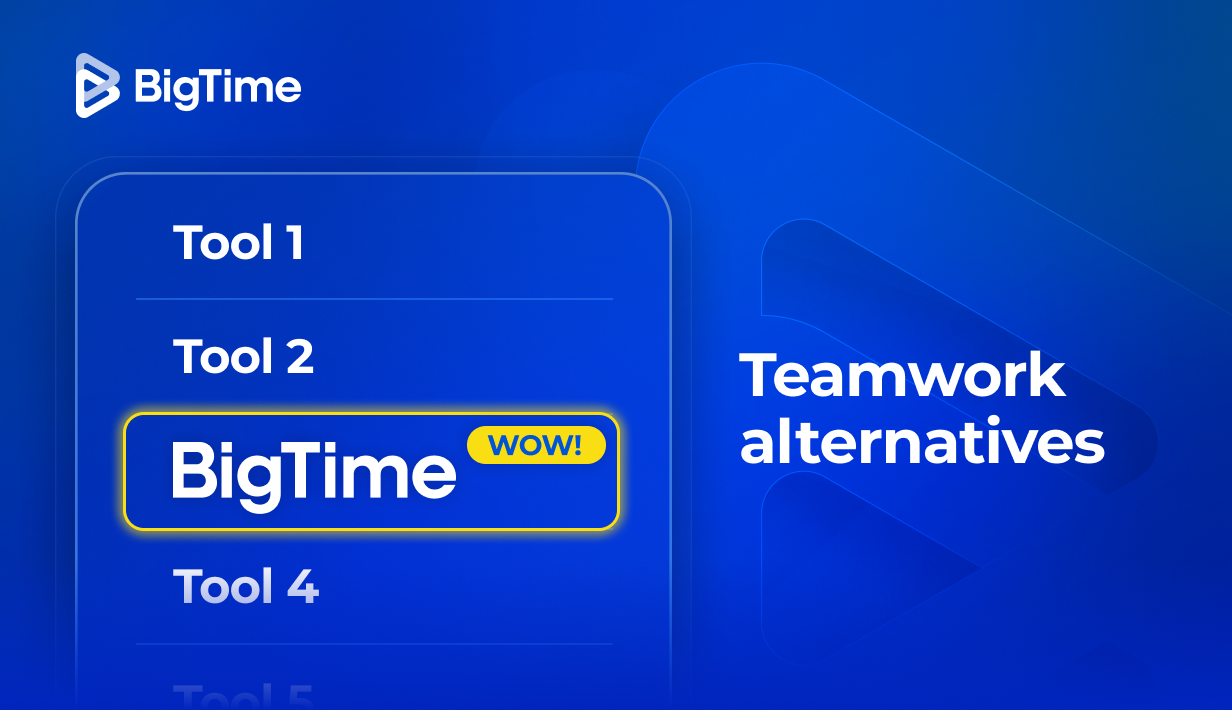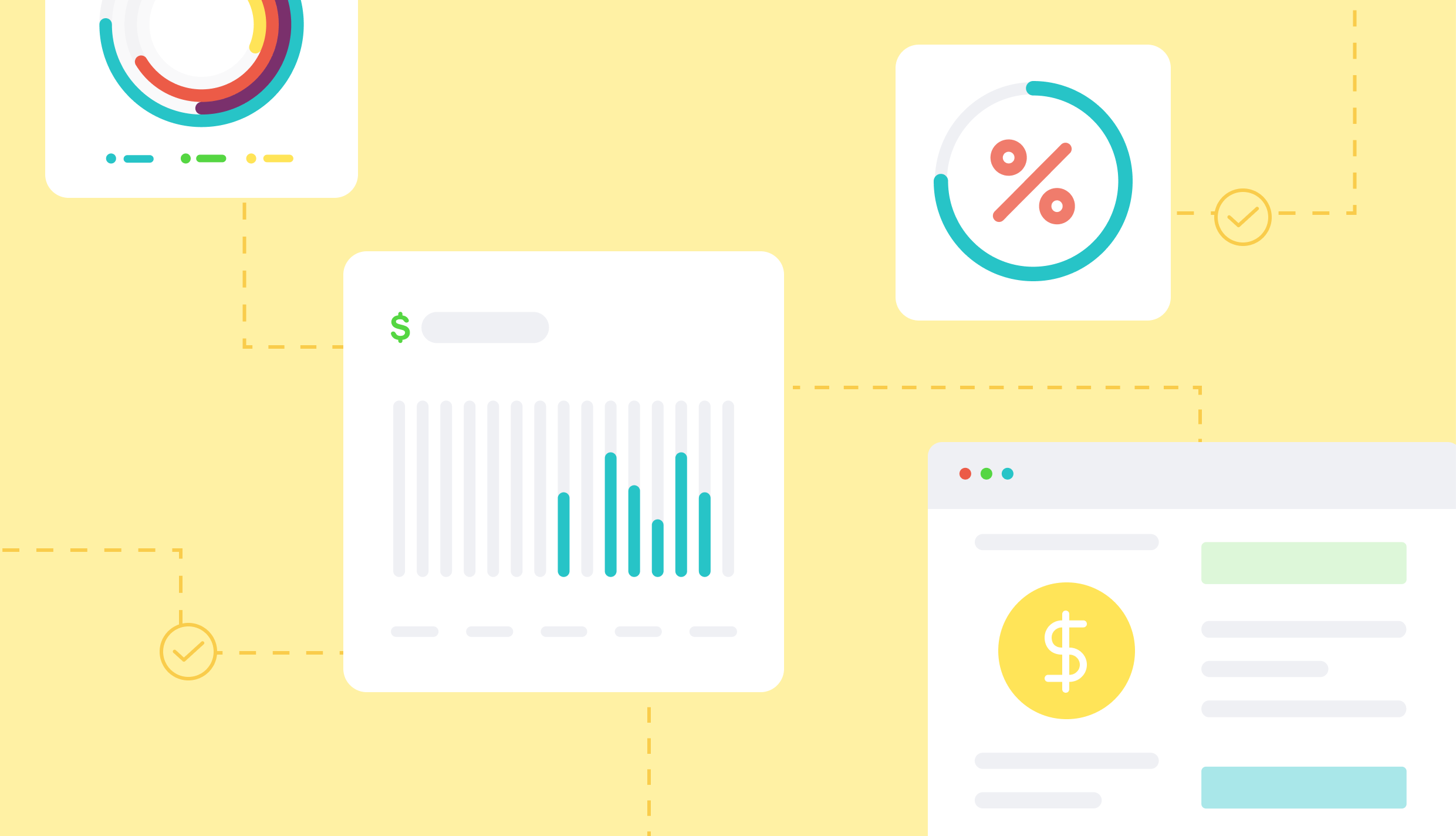While Teamwork is widely recognized as a versatile project management tool, many companies discover that its capabilities don’t fully meet their needs – especially as their projects become more complex. The good news is that there are plenty of alternatives to Teamwork offering unique strengths, more advanced features, or better scalability.
In this article, we’ll:
- Explain why teams seek out replacements for Teamwork.
- Highlight the essential features to look for in the right project management tool.
- Review and compare the 10 best Teamwork alternatives for 2025.
Why Consider an Alternative to Teamwork?
Teamwork does many things right. It offers clean boards, list views, task management, and integrated time tracking that’s helpful for service-based work. However, it can also feel limited when you try to scale beyond simple project timelines and move on towards more complex projects; and that’s the main reason why companies look for Teamwork alternatives.
Many organizations encounter bottlenecks when they need complex resource management or when they want real-time visibility into project profitability. Financial management tools are basic, forcing managers to juggle spreadsheets or third-party apps to ensure project success. Customization is another sticking point; while workflows can be adapted to a degree, the flexibility facilitating different project management styles isn’t on par with other modern platforms.
If your organization is:
- Managing multiple large-scale projects simultaneously,
- Need advanced features for team collaboration instead of a simple task management,
- Tracking capacity and utilization rates,
- Needing more robust analytics and forecasting, or
- Integrating project data with accounting and CRM tools,
…then it’s worth exploring Teamwork alternatives that combine advanced project management with deeper business intelligence.
Features the Best Teamwork Alternatives Should Offer
When replacing a tool like Teamwork, it’s not enough for the new software to simply manage tasks. A true upgrade will improve collaboration, visibility, and strategic planning across your entire business. Here’s what to look for:
- Advanced resource management. The best Teamwork alternatives let project managers schedule staff based on skills, availability, and workload, making handling complex projects a simple task. Look for features like drag-and-drop Gantt charts, capacity tracking, utilization forecasting, customizable templates and conflict alerts that help prevent overbooking in both new and ongoing projects.
- Integrated time tracking. Instead of separate tools for logging hours, the right platform will allow real-time tracking of both billable and non-billable hours, automatically linking them to projects for accurate reporting and invoicing.
- Comprehensive financial oversight. Budget planning, expense tracking, rate management, and profitability analysis should all be built in, helping you monitor project health without switching between multiple apps.
- Managing multiple projects. Every team has its preferred project delivery methods. Kanban boards, list views, calendars, and Gantt charts packed in a single intuitive interface should all be available so you can choose the right perspective for each project and control project workflows at the same time.
- Scalable reporting and dashboards. Reports should update automatically with real-time data, allowing you to track project KPIs, utilization, budgets, and timelines without manual input. Custom dashboards and other customizable reporting tools let you tailor insights for executives, managers, and clients. File sharing is a big plus, too!
- Automation and AI. Workflow automation reduces repetitive tasks, while AI-powered suggestions can help forecast deadlines, identify risks, and optimize resource allocation.
- Strong integrations. The right alternative to Teamwork should integrate with accounting platforms like QuickBooks, communication tools like Slack, and CRMs like HubSpot, creating a seamless ecosystem.
10 Best Teamwork Alternatives – Quick List
- BigTime – PSA platform combining project, resource, and financial control.
- Trello – Kanban board system for small projects.
- ClickUp – Fully customizable all-in-one workspace.
- Monday.com – Visual, adaptable project management boards.
- Wrike – Enterprise-ready with project planning tools.
- Notion – Flexible, database-driven workspace.
- Smartsheet – Spreadsheet-based project and resource tracking.
- Airtable – Database-style project organization tool.
- Basecamp – Simplified collaboration platform.
- Kantata – Professional services management with deep resource and finance tools.
2025 Teamwork Alternatives – Ranking Overview
The following ranking is based on scalability, feature range, ease of use, and suitability for professional services firms. Each tool here brings something unique, but some are more suitable for complex, growing teams than others.
Teamwork Alternatives Comparison
| Tool | Description | Strengths | Limitations |
| BigTime | PSA platform with project, resource, and financial tools. | Advanced features, scalable, strong analytics. | Higher learning curve. |
| Trello | Kanban boards for simple projects. | Very easy to use, affordable. | Limited advanced features. |
| ClickUp | Highly customizable work hub. | Multiple views, all-in-one platform. | Can be overwhelming. |
| Monday.com | Visual project boards. | Flexible workflows, colorful UI. | Clutter with complex setups. |
| Wrike | Enterprise project management. | Strong planning tools, security. | Expensive for large teams. |
| Notion | Modular notes + databases. | Extreme flexibility. | Needs strict organization. |
| Smartsheet | Spreadsheet-based PM. | Detailed control, data-rich. | Steep setup process. |
| Airtable | Flexible database workspace. | Rich customization. | Requires structure discipline. |
| Basecamp | Simplified PM + communication. | Easy adoption, flat pricing. | Too basic for complex PM. |
| Kantata | Service-focused PM tool. | Strong financial & resource planning. | Complex onboarding. |
BigTime
Reviews: G2: 4.5, Capterra: 4.6
Pros:
- Covers the full project lifecycle from planning to invoicing.
- Excellent scalability for growing teams.
- Industry-specific tools for professional services.
Cons:
- Takes time to master all features.
BigTime’s user friendly interface is designed for professional services firms that need a single platform to handle projects, resources, and finances and facilitate cross-team and cross-department collaboration.
Unlike Teamwork, it allows skill-based scheduling, utilization forecasting, budget control, and real-time profitability monitoring, all within one environment. Contrary to its competitors, BigTime is also a perfect choice for companies of all sizes, from small businesses to enterprises, allowing them to manage diverse projects without a steeper learning curve.
Additionally, BigTime includes essential features for advanced analysis and bird’s eye view of all the key processes. Its dashboards and reports turn raw data into actionable insights, bridging the gap between project, finances and invoices. Additionally, BigTime’s integrations with external tools such as QuickBooks, Sage, and CRM tools make it easy to connect with the rest of your business stack. As a result, it makes for a perfrect Teamwork alternative for all types of users in professional services, from creative agencies to IT companies.
Key Features:
- Project Planning: Create draft and final projects, predict project outcomes and test out different scenarios regardless of the project complexity to make the best possible decision every time.
- Resource Management: Assign based on skills and availability, adjust allocations in Gantt charts, and get alerts for conflicts.
- Project Budgeting & Forecasting: Track spending, compare against budget, and predict profitability.
- Time & Expense Tracking: Log hours directly against projects and link expenses for accurate billing.
- Invoicing: Create branded invoices from tracked work without exporting data.
- Reporting & Dashboards: Fully customizable, real-time metrics on utilization, project health, and revenue – document sharing and customizable templates included.
Pricing: From $20 per user per month; free trial available.
Trello
Reviews: G2: 4.4, Capterra: 4.5
Pros:
- Exceptionally easy for beginners to understand and use.
- Highly visual, with an intuitive card-and-board layout.
- Large marketplace of Power-Ups to extend capabilities.
Cons:
- Lacks advanced native features for resource, budget, or time tracking.
- Can quickly become disorganized without strict workflow rules.
- Reliance on third-party add-ons increases complexity and cost.
Trello is one of the most recognizable Kanban-based tools in the project management space. It thrives on simplicity: boards represent projects, lists act as stages, and cards hold the individual tasks or ideas.
However, when projects become complex, Trello’s minimalist core starts to show its limits. Many teams attempt to patch these gaps with Power-Ups, like adding calendar views, Gantt charts, or advanced automation, but these require careful integration and can add significant monthly costs. Trello also lacks built-in performance analytics making it difficult to track progress, so managers may struggle to get data-driven insights without external tools. As a result, for some more advanced organizations, it might not be the right alternative to Teamwork.
Key Features:
- Kanban Boards: Visual task management with easy drag-and-drop movement between stages.
- Custom Fields & Checklists: Add structured details and subtasks to cards for better clarity.
- Power-Ups: Enhance boards with additional functionality like reporting, time tracking, and integrations.
- Automation with Butler: Create rules, buttons, and scheduled commands to reduce repetitive updates.
- Collaboration Tools: Comment threads, file attachments, and @mentions within cards to centralize discussion.
Pricing: Free plan available; paid from $5 per user per month, with Premium plans offering more advanced views and administrative controls.
ClickUp
Reviews: G2: 4.7, Capterra: 4.7
Pros:
- Incredibly flexible, accommodating nearly any workflow.
- Combines tasks, documentation, goal tracking, and chat in one platform.
- Wide range of views and customization options.
Cons:
- Overwhelming feature set can confuse new users.
- Performance can slow in large workspaces with many automations.
- Some of the most useful features locked behind higher tiers.
ClickUp markets itself as “one app to replace them all,” aiming to centralize not only project management but also internal communication, documentation, and goal tracking. It supports multiple work styles with views ranging from lists and boards to Gantt charts and whiteboards, making it adaptable to agile, waterfall, and hybrid methodologies.
However, this level of flexibility can be a double-edged sword in this type of Teamwork alternatives. Without careful setup and ongoing maintenance, workspaces can become cluttered and inefficient. Teams often require training to take full advantage of the platform, and certain features that appeal to larger organizations are locked behind higher-tier plans. For smaller teams, the effort required to keep ClickUp organized might outweigh the benefits of its vast functionality.
Key Features:
- Multiple Views: Choose from List, Board, Calendar, Gantt, Timeline, and Mind Map to match different planning needs.
- Custom Fields & Statuses: Tailor workflows to match your exact process, from sales pipelines to product sprints.
- Docs & Whiteboards: Create collaborative documents and brainstorm visually without leaving the platform.
- Automations: Reduce repetitive tasks by setting triggers and actions, though complex setups may require trial and error.
- Dashboards & Reporting: Build visual summaries of project health, workload, and KPIs, with more advanced metrics on higher plans.
Pricing: Free plan available; paid plans start at $10/user/month (Unlimited), with Business and Enterprise tiers unlocking advanced capabilities.
Monday.com
Reviews: G2: 4.7, Capterra: 4.6
Pros:
- Extremely visual and engaging boards.
- Adaptable to a wide variety of workflows.
- Broad range of integrations for different industries.
Cons:
- Can become cluttered with too many boards or columns.
- Advanced features locked behind higher-tier plans.
Monday.com is a highly visual, flexible and popular project management software often mentioned as one of the Teamwork alternatives. Its colorful boards and customizable columns allow you to represent tasks, deadlines, project budgets, and assignees in whatever format fits your workflow best. The platform supports multiple views and offers built-in automation to handle repetitive updates.
However, this same flexibility can also lead to chaos. Without a clear governance plan, boards can quickly become cluttered with redundant columns or unused fields. Some features that make it more competitive with enterprise tools are only available on higher-tier plans.
Key Features:
- Customizable Boards: Design columns to track status, priority, owner, budget, or any other metric you need.
- Multiple Views: Switch between Kanban, Gantt, Timeline, and Calendar views without losing data.
- Automation Recipes: Build custom triggers and actions to handle repetitive tasks automatically.
- Integrations: Connect with Slack, Google Drive, Zoom, and hundreds of other tools for seamless workflows.
- Dashboards: Combine data from multiple boards into a single visual dashboard for management reporting.
Pricing: Free plan available; paid plans start at $9 per user per month (Basic plan), with advanced features in higher tiers.
Wrike
Reviews: G2: 4.2, Capterra: 4.3
Pros:
- Strong for cross-departmental project visibility.
- Powerful reporting and analytics features.
- Flexible enough for marketing, IT, and operations teams.
Cons:
- Steeper learning curve than most PM tools.
- Higher cost for advanced capabilities.
Wrike is a Teamwork alternative geared toward teams that need to coordinate complex projects across departments and document management. Its real-time dashboards, customizable workflows, and integrated proofing tools make it especially appealing for marketing and creative teams with multi-stage review processes looking for basic features and management tools.
But Wrike’s flexibility comes at a cost—new users may struggle with its layered interface, and smaller teams may find the price hard to justify. While Wrike can adapt to almost any workflow, it requires consistent training and governance to stay effective, making it difficult for team members to keep up with the active projects.
Key Features:
- Custom Workflows: Tailor statuses and processes for each department or project.
- Multiple Views: From Gantt to Kanban to table views for different preferences for data visualization.
- Proofing & Approvals: Leave contextual feedback directly on creative assets.
- Resource Management: Monitor team workload and allocate hours efficiently.
- Advanced Reports: Interactive, filterable reports for in-depth insights.
Pricing: Free plan available; paid plans start at $9.80/user/month.
Notion
Reviews: G2: 4.7, Capterra: 4.7
Pros:
- Combines note-taking, task tracking, and databases.
- Flexible enough to replace multiple apps for small teams.
- Excellent for internal documentation and wikis.
Cons:
- Lacks native advanced PM automation.
- Can become chaotic without strict organization standards.
Yet another Teamwork alternative, Notion, offers an open-ended platform where teams can create their own project tracking systems, wikis, and knowledge bases. It’s especially popular with startups and remote-first teams that want one tool for both collaboration and documentation.
However, it’s not a comprehensive project management tool you might look for when searching for Teamwork alternatives. Without discipline, pages can sprawl into a mess of unlinked documents and outdated databases, limiting the view of project progress and key statistics. Teams that need structured, automated workflows might find Notion too loose compared to purpose-built PM tools.
Key Features:
- Linked Databases: Build relationships between projects, tasks, and resources.
- Multiple Views: Kanban, calendar, gallery, and table views.
- Templates: Pre-made layouts for roadmaps, product launches, or wikis.
- Collaboration: Real-time editing, comments, and mentions.
- Embedded Content: Integrate videos, Figma files, and external docs.
Pricing: Free plan available; pricing plans start at $8 per user per month.
Smartsheet
Reviews: G2: 4.4, Capterra: 4.5
Pros:
- Ideal for teams already comfortable with spreadsheets.
- Capable of managing highly complex, data-heavy projects.
- Robust automation and integration features.
Cons:
- Steep learning curve for non-technical users.
- Interface feels less modern compared to other PM tools.
Smartsheet is essentially a spreadsheet supercharged with project management capabilities. It’s particularly popular in industries like construction, manufacturing, and operations – fields where teams are already managing large amounts of data in Excel and need collaborative, real-time access.
One of its strengths is its ability to handle complex project dependencies and formulas across multiple sheets, making it ideal for large-scale initiatives that require precise tracking of resources, budgets, and timelines. However, for teams used to visual-first tools Smartsheet’s grid-heavy interface can feel less intuitive. To fully leverage its capabilities, teams should invest in structured onboarding and clear naming conventions.
Key Features:
- Multiple Views: Switch between grid (spreadsheet), Gantt, calendar, and card views to suit different work styles.
- Automation Rules: Set up automatic notifications, task assignments, and status changes based on triggers.
- Cell Linking & Formulas: Link data across sheets and use formulas for complex calculations, forecasting, and conditional logic.
- Resource Management: Manage workloads and prevent over-allocation through built-in resource views.
- Dashboards & Reports: Combine multiple data sources into interactive, real-time performance dashboards for stakeholders.
Pricing: Paid plans start at $7/user/month (Pro) and $25/user/month (Business), with advanced enterprise controls available on custom plans.
Airtable
Reviews: G2: 4.7, Capterra: 4.7
Pros:
- Blends the familiarity of spreadsheets with database power.
- Extremely customizable for a wide range of workflows.
- Offers multiple visual formats for analyzing the same data.
Cons:
- Requires careful database design to avoid clutter.
- Advanced features like syncing, permissions, and automation require higher-tier plans.
Airtable is one of the most flexible Teamwork alternatives, allowing teams to build bespoke online project management systems without code. It’s especially popular with marketing agencies, product development teams, and editorial departments thanks to its ability to store and link large amounts of structured data; think content calendars, campaign assets, or product launch timelines.
Unlike traditional PM tools, Airtable is more of a “framework” than a fixed solution. You can set up tables for projects, link them to tables for team members or clients, and view the data in multiple ways, from Kanban boards to Gantt timelines. But with great flexibility comes great responsibility: without strong guidelines for structure, bases can become unwieldy, leading to data duplication and confusion.
Key Features:
- Views: Work with grid, Kanban, gallery, calendar, and timeline formats to visualize projects from different perspectives.
- Linked Records: Create relationships between tables—e.g., linking tasks to campaigns or assets to team members—for dynamic data connections.
- Rich Field Types: Use attachments, dropdowns, checkboxes, formulas, and even barcodes to customize your data fields.
- Automations: Automate repetitive steps like sending email updates or updating task statuses based on triggers.
- Integrations: Connect with hundreds of tools via native integrations and platforms like Zapier, enabling data flow across your software stack.
Pricing: Free plan available; paid plans start at $10/user/month (Plus), with Pro and Enterprise tiers for advanced automation and controls.
Basecamp
Reviews: G2: 4.1, Capterra: 4.3
Pros:
- Extremely simple to learn and use.
- Combines communication, task tracking, and file sharing in one tool.
- Flat-rate pricing benefits larger teams.
Cons:
- Lacks many advanced PM features like Gantt charts, workload views, and advanced reporting.
- Minimal customization options for workflows.
Basecamp takes a deliberately minimalist approach to project management, focusing on communication and basic task tracking rather than complex scheduling. Its streamlined toolset – message boards, to-do lists, calendars, group chat, and file storage – makes it ideal for small businesses, nonprofits, or teams looking to minimize software overhead and avoid tool overload.
That simplicity, however, can quickly become a limitation for growing teams or complex projects. Without features like dependencies, advanced reporting, or detailed resource allocation, project managers often have to rely on supplementary tools. Still, for organizations prioritizing straightforward coordination and centralized communication, Basecamp delivers a distraction-free environment.
Key Features:
- Message Boards: Keep discussions organized by topic and reduce reliance on email.
- To-Do Lists: Assign tasks with deadlines, track completion, and keep deliverables organized.
- Campfire Chat: Hold quick, real-time conversations without switching to a separate app.
- Schedules: Track key dates and milestones in a shared calendar.
- Docs & Files: Store project documents, images, and resources in a central location accessible to the whole team.
Pricing: Flat $99/month for unlimited users (Business plan) or free Personal plan for up to 20 users and 3 projects.
Kantata
Reviews: G2: 4.2, Capterra: 4.2
Pros:
- Purpose-built for professional services organizations.
- Deep resource management and financial tracking capabilities.
- Detailed, client-ready reporting.
Cons:
- Long setup and onboarding process.
- User interface less modern compared to newer tools.
Kantata (formerly Mavenlink) is a specialized Teamwork alternative for service-based firms like consultancies, agencies, and engineering companies. It covers every stage of the project lifecycle within a single environment. This makes it a powerful choice for teams that need to track not just tasks, but also utilization rates, billable hours, and project profitability.
Where Kantata shines is in its detailed resource planning tools, which allow managers to assign people based on skills, availability, and cost, then monitor those assignments against budget and timeline constraints. Its financial tools integrate with time tracking, meaning you can create invoices directly from logged work. However, this sophistication comes at the cost of a steeper learning curve, and smaller teams might find the platform more than they need.
Key Features:
- Project Timelines & Dependencies: Plan deliverables in detail, linking tasks to ensure smooth sequencing.
- Resource Planning: Assign staff to projects based on skills, availability, and profitability goals.
- Time & Expense Tracking: Capture billable hours and costs directly within the platform.
- Financial Management: Monitor budgets, margins, and revenue forecasts with integrated tools.
- Advanced Reporting: Create in-depth operational and financial reports for both internal stakeholders and clients.
Pricing: Custom pricing based on team size, project volume, and required features.
Which Teamwork Alternative Should You Choose?
While all the Teamwork alternatives we’ve discussed have their own merits, the right choice ultimately depends on the complexity of your projects, the size of your team, and your long-term growth goals.
However, if your goal is to move beyond basic task tracking into a truly unified project, resource, and financial management system, BigTime stands out as the most comprehensive Teamwork alternative on the market. Unlike Teamwork, which primarily focuses on task organization and time tracking, BigTime covers the entire project lifecycle. From forecasting resource needs and scheduling staff by skill, to tracking every billable hour, monitoring budgets, and generating branded invoices—BigTime keeps everything in one integrated environment.
What truly sets BigTime apart is its scalability. Many teams eventually “outgrow” their project management tool when they start handling more complex, multi-client operations; but BigTime is built to grow with you. Whether you’re a small agency or a large professional services firm, its advanced reporting turns live data into actionable insights, helping you improve utilization rates, maintain profitability, and make confident business decisions in real time.
If you’re ready to replace Teamwork with a platform that gives you complete visibility and control over your operations, BigTime is the clear choice.





